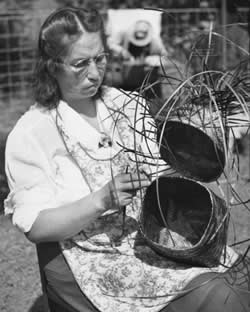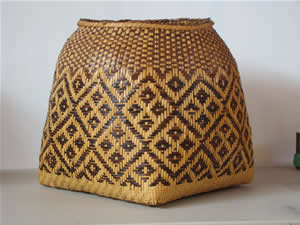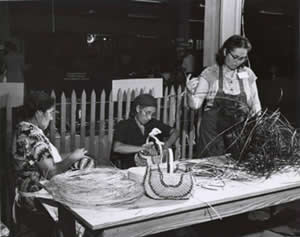People: Lottie Stamper
Lottie Queen Stamper (1907-1987) was one of Cherokee's best-known basket weavers. She was recognized for her versatility and innovation, with many crediting her with reintroducing the double weave technique into modern Cherokee culture. Like most Cherokee basket weavers, she initially learned the craft from her mother, but later honed her skill when she married into another basket making family. Stamper taught classes from 1937 until 1966, exposing hundreds of girls to the basketry tradition. Her signature appears with 100 other craft workers who signed on to become members of the newly formed Qualla Arts and Craft Mutual cooperative in 1946. In 1952, the Southern Highland Handicraft Guild awarded her an honorary lifetime membership.
Lottie Queen was born January 4, 1907, on the Qualla Boundary, lands owned by the Eastern Band of Cherokee Indians. She was the fifth of six children born to Levi and Mary Queen. Her mother was a white oak basket weaver who taught her children how to make baskets.
“The whole family of us learned basket weaving from our mother. But it took a good bit of practice to really make a good basket. When I did learn it meant new clothes and shoes to wear back to school each fall of the year. This was my very first experience to make and sell a basket.”
Selling baskets was an activity unto itself. Before good roads attracted visitors to the western North Carolina mountains, Mary Queen and her daughter, Lottie walked long distances to sell their family’s baskets. On foot, they traveled to Waynesville or Junaluska, a round trip distance of 50 miles. 1
The Queen family lived on a wooded piece of land in the Soco section of the Boundary. The family farmed and made baskets “after the cultivation of the fields and garden was over,” Stamper explained. In a later interview, Stamper described her earliest experiences making baskets. She recalled that her father helped to gather materials, but her mother who made the weaving splints.
“I remember very well when I was a child when he and my mother used to go to the hills to get white oak saplings. That was after the cultivation of the fields and garden was over. This was the beginning process of white oak basketry. He split the logs into lengthwise pieces and I had to watch on closely, and from this my mother began making the splints one by one. This process wasn’t so easy until you learned how, because it took a while to learn the pulls she made to the end of the stick.”
Mary Queen not only taught her children technique, but also the importance of quality. Stamper recalled that sometimes she made her baskets with tears in her eyes, until she received her mother’s approval. 2
Lottie Queen married Bill Stamper and moved to the Painttown community. In 1935, when she was 28 years old, Lottie Stamper learned to make rivercane baskets using the single weave technique. Bill’s mother, Sally Ann Crowe Stamper, and his sister, Lizzie Stamper Youngbird, were accomplished basket weavers. Marrying into a basket weaving family gave Stamper the opportunity to expand her skills. Besides learning to work rivercane, she also learned to use native plants to dye basket splints. Her own mother made baskets but did not dye the white oak splints, preferring instead to produce baskets that were the natural blonde color of wood. Stamper stated her preference for natural dyes, using the “roots of the butternut tree and the roots of the bloodroot,” explaining that the color “never fades away.”3
Stamper gained a reputation for herself in a short period of time. Just two years later, Stamper was visited by Cherokee Boarding School Principal, Sam Gilliam and Gertrude Flanagan, Home Economics Teacher to see if she would teach basketry. In her classes, she taught all forms of basket weaving, including white oak , rivercane , and honeysuckle. Stamper was curious and determined; she collected old patterns, copied them into notebooks, and reproduced them on graph paper. Graph paper designs and photographs of rivercane baskets hung on the walls of her classroom. In popularizing the craft, over the course of a 30-year teaching career, Stamper exposed hundreds of girls to their own Cherokee traditions. Stamper’s work with basket weaving patterns changed the way traditions were shared. Sarah Hill, author of Weaving New Worlds: Southeastern Cherokee Women and their Basketry, commented on this change:
“Patterns that once belonged to families became common property. And patterns that once belonged only to rivercane were shared with white oak...The old rivercane designs hanging on the classroom walls represented a great deal more than weaving techniques. They were strands that connected family members...and interwove past and present.” 4
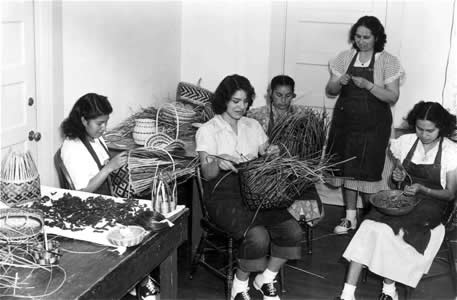
Lottie Stamper (standing) teaching a basketry class |
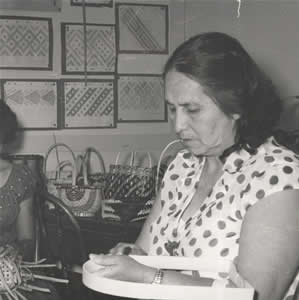
Stamper with basket patterns posted in classroom |
As a basketry teacher and student of the craft, Lottie Stamper wanted to learn the double weave technique. The double weave-a method of weaving that produces a double-walled basket-has been documented to predate contact with European explorers. Stamper approached Rebecca Toineeta, a basket weaver and elder, to ask her help in making such a basket, but the relationship between the two women was short-lived. Stamper recalled, “Old lady Mrs. Toineeta, who lived on Swimmer Branch, didn’t much want to [teach me], but I bothered her until she showed and told me a little bit about it.” 5 Apparently what she learned was enough for Stamper to get started. When she next returned, she was told not to come back.
In 1940 Stamper came across a photograph of a double weave basket that was in the collection of the British Museum. This lidded basket-or set of two closely fitted baskets-was carried to London by Sir Francis Nicholson (1655-1728). In the 1720s, Nicholson served as the Royal Governor of South Carolina, traditionally part of the Cherokee homeland. Studying the photograph of these baskets, now in the collection of the British Museum, Stamper painstakingly worked out the design of this basket, taking a full 2 ½ days to work out the pattern. Using 500 splits, Stamper wove her own replica of the baskets. “This, indeed, was the happiest day of my life,” she recalled. “Now it was my duty to teach it to my brightest students, and it was their happiest when they learned theirs.” 6 Stamper’s “discovery” attracted attention and reinforced the tradition of double weave among Eastern Band Cherokee Indians.
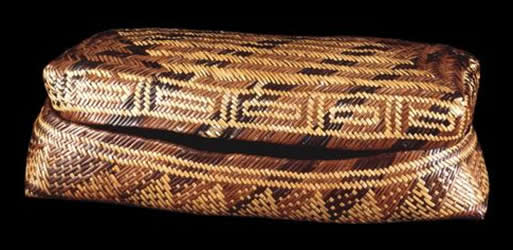
Nicholson baskets, before 1725 in the collection of the British Museum |
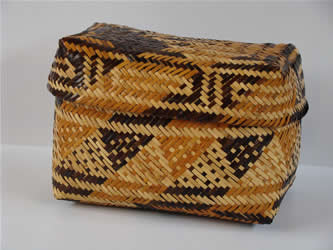
Contemporary intepretation by Carol Welch |
Some sources claim that Stamper reintroduced a “lost” technique, while others argue that the skill had remained with elders of the tribe. Author Sarah Hill names some who still wove this type of basket, including Nancy and Rowena Bradley, and Aggie Wilnoty George, in addition to Mrs. Toineeta. Still, there were few who were accomplished in the making of the complex double weave technique. 7
What makes a double weave basket so difficult? It is two baskets in one, woven in one piece. The basket is begun at the bottom and woven upward. At the rim, it is turned outward and woven back down to the base. The result is a basket within a basket, a basket with double walls. If woven tightly enough, a double weave basket is said to hold water.
Besides teaching at the Cherokee Boarding School, Stamper later taught at the Cherokee High School and traveled to Mississippi to teach basketry among the Choctaw. She demonstrated at the Craftsman’s Fair of the Southern Highlands as a member of the Southern Highland Handicraft Guild. In 1952 Stamper was honored with a lifetime achievement award from the guild, the first Native American to win this award. In 1967 she was one of three Native Americans included in the book Artisans of the Appalachians. The book introduced Stamper with the statement, “Everybody thinks of Lottie Stamper when Cherokee baskets are mentioned, so it seems.” In her lifetime, Lottie Stamper is said to have made “thousands of baskets.” 8
Anna Fariello
Excerpted from Cherokee Basketry: From the Hands of our Elders,
Published by The History Press, 2009
1. Tommy Jo Bookout, Traditional Basketmakers in the Southeastern and South Central United States (Ann Arbor: UMI, 1987) 103; Rodney L. Leftwich, Arts and Crafts of the Cherokee (Cherokee: Cherokee Publications, 1970) 2. In a 1965 interview by Edward DuPuy, Stamper was quoted as saying that she learned to make pine needle baskets as well. Pine needle baskets are more commonly made in coastal areas in the eastern US.
2. Bookout, 103.
3. Bookout, 103.
4. Bookout, 103; Sarah H. Hill, Weaving New Worlds: Southeastern Cherokee Women and their Basketry (Chapel Hill: University of NC Press, 1997) 300-302.
5. Bookout, 104.
6. While many sources note that Stamper received this photograph only one reports its source. According to Bonita Freeman-Witthoft in “Cherokee IndianCraftswomen and the Economy ofBasketry,”Expedition:TheMagazineofArchaeologyAnthropology19,no.3(spring1977),thephotographwasgiventoStamperbyVirginiaHunter,ananthropologystudent.Hill,300;Bookout,104
7. Hill, 300.
8. Both the Choctaw and the Chitimacha are southeastern tribes who make cane baskets. Edward L. DuPuy, Artisans of the Appalachians (Asheville, N.C.:Miller Print Co., 1967) 4-5.

